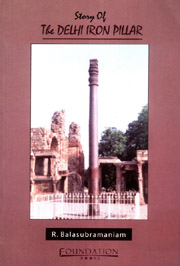4 - Manufacturing Methodology
Published online by Cambridge University Press: 26 October 2011
Summary
A discussion on the manufacture of the Iron Pillar throws up several questions. How did the ancient Indians extract iron from iron ore? What is the composition of the material in the pillar? Very importantly, how was it manufactured? The Delhi Iron Pillar is a large mass of iron, weighing about 6 tons, which is nearly the weight of a full-grown male elephant! It is difficult to even imagine how such a huge mass of iron was lifted and manipulated during manufacture. But they managed to do it. How? Finally, having made the pillar, how was the surface polished? This chapter tries to answer these questions. Like any other work of engineering excellence, the design and manufacture of the Iron Pillar must have been planned precisely, well in advance. Additionally, the artisans must have initially worked out the mechanisms of producing such a massive pillar by conducting a trial run, possibly by manufacturing an Iron Pillar of a much smaller size. This kind of prototyping is also carried out in modern engineering design and construction where the final design is tested on a smaller scale to check the viability of the idea and also to obtain ideas on how the product can be manufactured. Prototyping helps to understand some of the possible pitfalls in the design or the process of making it.
How did the Ancient Indians Extract Iron?
You may wonder why it is necessary to understand the method of iron extraction to understand the manufacture of the Iron Pillar. It is for the simple reason that iron lumps were the starting material for the construction of the pillar.
- Type
- Chapter
- Information
- Story of the Delhi Iron Pillar , pp. 46 - 64Publisher: Foundation BooksPrint publication year: 2005



